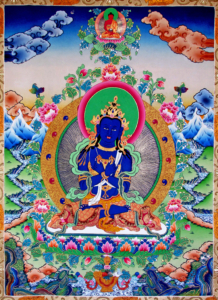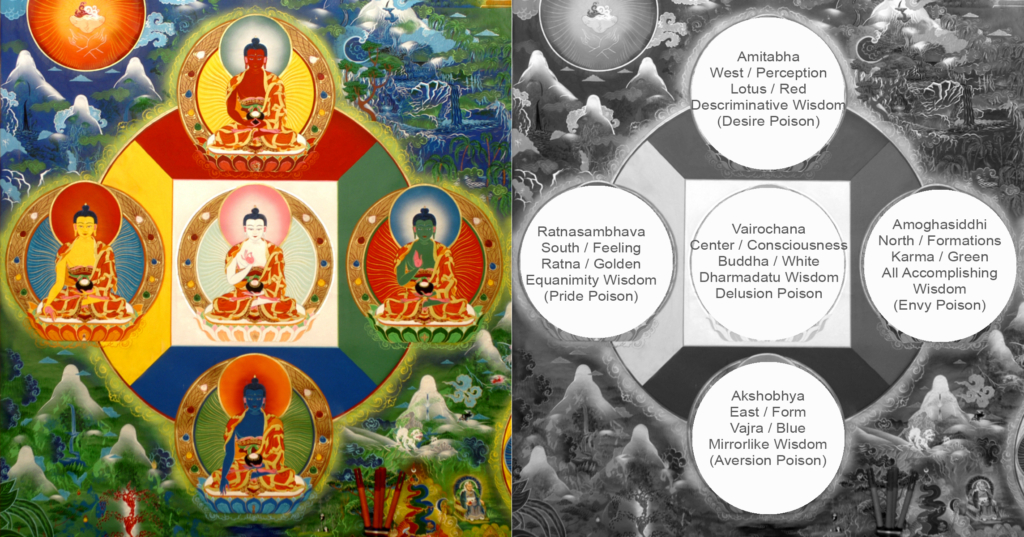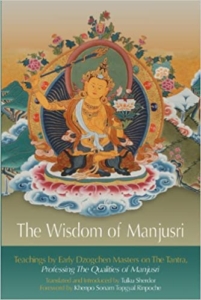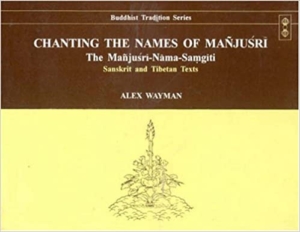On August 16, 2020, Dirk Johnson discussed the Tantra of Chanting the Names of Manjushri.
Following are the notes for this talk, also available here as a PDF.
English: Litany of the Names of Manjushri / or / Chanting the Names of Manjusri / or / A Concert of Names of Manjushri
Tibetan: ’jam dpal mtshan brjod
Sanskrit: Manjushri-nama-samgiti
Also referred to as The King of All Tantras and Net of Magical Manifestation of Manjushri
An extremely important tantric text, relied on by all the schools of Tibetan Buddhism. In particular, the commentaries connect it with the Hevajra, Guhyagarbha, and Kalachakra tantras.
Unless you have already mastered this material and its underlying sources, you will find my talk confusing. This is actually a good thing. Sometimes it’s good to be spoon fed easily digestible bites. But It’s also good to be dropped into the middle of the mandala with all of the confusion and disorientation that might entail. This way what you already know and what you think you know can’t take control of the material and you have an opportunity to go past your own preconceptions about what Buddhism is and what the world is.
All of this, without exception, is an attempt to categorize and classify something which is beyond classification and categorization.
Preliminary Materials
The 5 Dhyani (Meditation) Buddhas (the Five Buddha Families)
The Five Dhyani Buddhas are fundamental to Mahayana Buddhism and in particular to Tantric Buddhism. This is a basic pattern that it would be good to learn if you don’t already know it. “Chanting the Names of Manjushri” presumes that you already know about these Buddhas, so I’m going to provide a brief introduction to them.
The Dhyani Buddhas are a profound subject by themselves. Although I’ve received extensive teachings about them, in particular from H.H. Pema Norbu Rinpoche and H.E. Chagdud Tulku Rinpoche in relation to the Shi-Tro or 42 Peaceful and 59 Wrathful Deities of the Guhyagarbha Tantra and the Bardo Thodol (“Liberation on Hearing in the Bardo, best known in English as “The Tibetan Book of the Dead”), I don’t claim to have mastered the iconography, symbolism, or profound meanings of these Buddhas. But I know enough to confuse you and give you a starting point.
Here is the basic layout. If you delve into the subject you will find variations that will likely confuse you.
Sixth Family / Vajradhara
 I’m not going to go into many details because I don’t want to get bogged down in details before you’ve even read “Chanting the Names of Manjushri.” But this ground must be covered, so:
I’m not going to go into many details because I don’t want to get bogged down in details before you’ve even read “Chanting the Names of Manjushri.” But this ground must be covered, so:
In the Guyasamaja Tantra, Vajradhara is the Adi Buddha. But sometimes, Vajradhara represents something sort of “intermediate” between the Dhyani Buddhas and the Primordial Buddha: he represents a Sixth Family, which includes all of the aspects and attributes of the Five Families rolled up into one..
And Then There’s The Adi-Buddha / Primordial Buddha
The Adi-Buddha is the first Buddha. In Vajrayana, the Adi-Buddha is usually referred to as Samantabhadra, Vajradhara, or Kalachakra, depending on which school and/or Tantra is governing the designation. From the Nyingma point of view, this is Samantabhadra, the Primordial Buddha, the Buddha that came before there was a division between Buddhas and beings. In the Sarma Schools, the Adi-Buddha is generally considered to be Vajradhara, a manifestation of the three vajras, the three Buddha Bodies. Kalachakra is the Adi-Buddha from the point of view of the Kalachakra Tantra, a Tantra practiced in all of the major Tibetan schools.
In most of China and Southeast Asia, the Adi-Buddha is Vairochana, the head of the Buddha Family in the schema laid out above. It might be interesting to consider how the idea of an Adi-Buddha is treated by different cultures and different times.
Two and Three Kayas
The Buddha Kayas are another profound subject. The two Kayas are the Dharmakaya (Truth Body) and the Rupakaya (Form Body). The Rupakaya is further divided into the Sambhogakaya (Enjoyment Body) and Nirmanakaya (Emanation Body). So far, we have only considered the Sambhogakaya.
Our Text: Chanting the Names of Manjushri
Our text is a Tantra, which comes from the cycle known as The Net of Magical Emancipation. Within this cycle, only two Tantras have extensive commentarial traditions in both India and Tibet: The Secret Nucleus (Guhyagarbha Tantra) and Chanting the Names of Manjushri
Chanting the Names of Manjushri has pride of place in the Tantra (rGyud ‘bum / Gyubum) section of the Derge edition of the Kanjur (Words of the Buddha), coming even before the Kalachakra Tantra. In addition, the commentarial tradition as preserved in the Tengyur (the canonical collection of treatises) contains interpretations of our text from a variety of Tantric viewpoints. As Gyurme Dorje put it in footnote 21 to The Complete Nyingma Tradition from Sutra to Tantra, Books 15 to 17: The Essential Tantras of Mahayoga, of which Litany of the Names of Manjushri and an interlinear commentary by Candragomin comprise Book 17, Part II:
Its extant Indic commentaries preserved in the Tengyur include six classed alongside the commentaries on the Tantra of the Wheel of Time [Kalachakra] (T 1395– 1400), twenty-one classed alongside other Yoganiruttara tantras (T 2090– 2110), and ninety that are classed within the Yogatantras (T 2532– 621). Indigenous Tibetan commentaries on the Litany of the Names of Mañjuśrī are far fewer, including those by Rongzom Chokyi Zangpo, Bodong Paṇchen, Dalai Lama II Gendun Gyatso, and Dzogchen Khenchen Jigme Yontan Gonpo. The only other significant tantras of the Mahāyoga genre outside the cycle of the Net of Magical Emanation with extensive commentarial literature appear to be the Tantra of the Secret Assembly (Guhyasamājatantra) and the Tantra of Vajrakīla in Twelve Sections (Ki la ya tantra bcu gnyis).
Our text begins with a request to Shakyamuni Buddha from Vajrapani in the form of Vajradara. Vajrapani asks Buddha Shakyamuni to teach him the Names of Manjushri and promises to teach them widely.
Excerpts from Chanting The Names of Manjushri
Read Verses 1 – 16 (The Request)
27, 79, 100, 103, 108, 123, 139, 150, 168
The Seven Mandalas of the Manjushri-nama-samgiti
Chapter names are from Alex Wayman (1983), those in parenthesis are chapter headings in Ronald Davidson (1995), square brackets from Alexander Berzin (date unknown), and those in curly brackets are from Gyurme Dorje (2016).
| Chapter of the Manjushri-nama-samgiti | Verses | Buddha | Family | Manjushri Name |
| IV. Dharmadhatu-Vagishvara: Speech-Lord of the Dharma Realm
(Three Verses on the Steps in the Realization Process of Illusion’s Net) [Three Verses on the Steps of Manifest Enlightenment by Means of Illusion’s Net] {Maifest Elightenment} |
25 – 27 | Ati or Primordial Buddha, Dharmadhatu Vagishvara | Manjugosha | |
| V. The Great Mandala of Vajradhatu (Fourteen Verses on the Vajradhatu Mahamandala)[Fourteen Verses on the Great Mandala of the Vajra Sphere]{Eulogy to the Mandala of the Indestructible Expanse} |
28 – 41 | Vairocana | Buddha
(Tathagata or Triple) |
White Prajnajnanamurti |
| VI. The Pure Dharmadhatu Wisdom (Twenty-Five Verses, Less a Quarter, on the very Pure Dharmadhatu Gnosis)[Twenty-five Verses, Less a Quarter, on the Deep Awareness of the Totally Pure Sphere of Reality]{The Pristine Cognition of Reality’s Expanse} |
42 – 66 | Amoghasiddhi | [Karma]
(Mahamudra or Bodhicittavajra) |
White Arapacana |
| VII. The Mirrorlike Wisdom
(Ten Verses, Plus a Quarter, on the Mirror-Like Gnosis) [Ten Verses, Plus a Quarter, Praising Mirror-like Deep Awareness] {The Mirrorlike Pristine Cognition} |
67 – 76 | Akshobhya | Vajra
(Vajra or that illumines the world) |
Blue Duhkhaccheda, Wrathrul |
| VIII. Discriminative Wisdom
(Forty-Two Verses on the Gnosis in Individual Inspection) [Forty-two Verses on Individualizing Deep Awareness] {The Pristine Cognition of Discernment} |
77 – 118 | Amitabha | Lotus
(Lotus or the mundane and supramundane) |
Red Vajratiksna |
| IX. The Sameness Wisdom
(Twenty-Four Verses on the Gnosis of Equality) [Twenty-four Verses on Equalizing Deep Awareness] {The Pristine Cognition of Sameness} |
119 – 142 | Ratnasambhava | Jewel (Ratna or Mahaushnisha) |
Yellow Vagisvara |
| X. Procedure of Duty Wisdom
(No Heading) [Fifteen Verses on the Accomplishing Deep Awareness] {The Pristine Cognition of Accomplishment} |
143 – 157 | Vajrasattva (Wayman) | [Vajra]
{Karma or retaining mantra or Vidya) |
Green Jnanakaya |
Resources and Translations
Translations
Alexander Berzin (Date Unknown)
“A Concert of Names of Manjushri,” by Alexander Berzin
https://studybuddhism.com/en/advanced-studies/prayers-rituals/prayers/a-concert-of-names-of-manjushri
Ronald Davidson (1995)
“Chanting the Names of Manjushri,” by Ronald Davidson at FPMT (PDF)
https://fpmt.org/wp-content/uploads/education/teachings/texts/prayers-practices/chanting_names_manjushri_c5.pdf
Gyurme Dorje (2016)
“The Litany of the Names of Manjushri,” which is Book 17, Part 2 of
The Complete Nyingma Tradition from Sutra to Tantra, Books 15 – 17: The Essential Tantras of Mahayoga, by Choying Tobden Dorje
This text includes the most comprehensive commentary in English on the Names, an interlinear commentary by Candrogomin titled Extensive Commentary on the Sublime Litany of the Names of Manjushri
https://www.shambhala.com/the-complete-nyingma-tradition-from-sutra-to-tantra-books-15-to-17-3407.html
Tulku Sherdor (2012)
The Wisdom of Manjusri includes a translation of the root text (translated as “Professing the Qualities of Manjusri”) and Vimalamitra’s commentary plus Garab Dorje’s commentary set into notes. The commentaries and translations are both very useful and rewarding. Available in both paperback and Kindle formats.
https://www.amazon.com/Wisdom-Manjusri-Vimalamitra/dp/0980173043/
Alex Wayman (1983)
Chanting the Names of Manjushri, by Alex Wayman
https://www.amazon.com/Chanting-Names-Manjusri-Manjusri-Nama-Samgiti-Tradition/dp/8120816536
Other Resources
Chanting the Names of Manjushri: A Reader’s Guide | Shambhala
https://www.shambhala.com/chanting-the-names-of-manjushri/
Dzongsar Khyentse, Global Recitation of the Names of Manjushri, July 25, 2020 (YouTube)
https://youtu.be/3ozwHOeaIzI
Lama Zopa: Chanting the Names of Manjushri (Manjushri-nama-samgiti) (Audio)
Chanted in Tibetan and with a brief commentary
https://www.lamayeshe.com/article/chanting-names-manjushri-manjushri-nama-samgiti-audio




